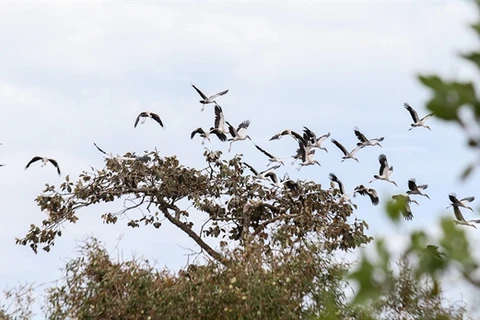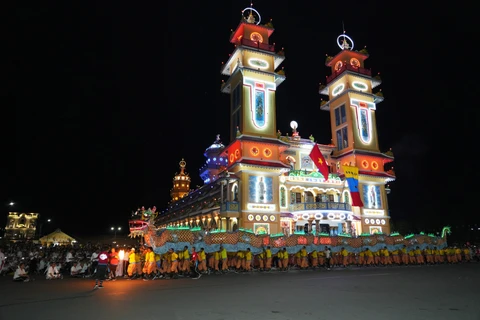Hanoi (VNA) - Tourism continues to be a bright spot in the southwestern province of Tay Ninh’s economic growth panorama this year, showing impressive development with increases logged in both the number of visitors and revenue.
In 2023, the province's tourism industry is estimated to grow by 5.5% compared to the plan, surpassing the average national growth rate.
According to statistics from the provincial Department of Culture, Sports, and Tourism, its total revenue is projected to reach 2 trillion VND (82.48 million USD), increasing by 11.1% compared to the plan and 36.5% to that of last year. It has hosted more than 5.1 million tourists, up 2% from the yearly plan and 13.2% year-on-year. The growth in arrivals has driven the expansion of the local accommodation and dining sectors and other services.
This positive outcome is attributed to the province's development directions, including organising promotional activities with a focus on the Ba Den national tourist area and enhancing the quality of tourist attractions and accommodation facilities. Tay Ninh also hosted various national and regional sports events and a tourism promotion programme in Hanoi.
Leveraging its agricultural strengths, the province is implementing a rural tourism development programme as part of its 2023-2025 rural development phase. It works to capitalise on the potential and advantages of agriculture, traditional villages, culture, and ecological environments across its localities. The aims are to improve the material and spiritual lives of rural residents and to support the transformation of the rural economic structure towards integrated, comprehensive, and sustainable development.
As per the provincial People's Committee plan, by 2025, there will be at least one recognised rural tourism site linked to local advantages of agriculture, culture, traditional villages, or ecological environments. Additionally, 50% of the recognised rural tourism businesses will meet tourist service standards, and at least 50% of the rural tourism sites will be digitised. All rural tourism sites will be introduced and promoted, with 50% of them utilising electronic transactions in their tourism activities.
Furthermore, each potential new-style rural district is expected to build at least one model of an agricultural and rural tourism development chain. At least 70% of the local business owners and 80% of the workers in the field should be trained. It is necessary to establish a database and digital map of rural tourism sites in the province.
Tay Ninh is also implementing plans to collaborate and develop tourism partnerships with provinces in the southeastern region, while intensifying its domestic and international tourism promotion efforts. These initiatives aim to leave a lasting mark, create more opportunities for partnerships among businesses involved, and attract more investment.
The province is home to the Ba Den Mountain Relic and Cultural Complex, which has been an attractive tourist destination for pilgrims and lovers of culture and nature in recent years. The Ba Den Mountain, dubbed the roof of southern Vietnam, is an ideal weekend trekking destination, rewarding visitors with heavenly views of floating clouds and unspoiled nature. Meanwhile, the 300-year-old Ba (Lady) Temple, a sacred place for Buddhists, was built on the mountainside, luring thousands of pilgrims on an annual basis.
Another popular tourist attraction is the Cao Dai Tay Ninh Holy See – the headquarters of Caodaism. The giant, bright temple, which was built in 1931 and officially inaugurated in 1955, is the most important shrine for the religion’s four million followers./.

























